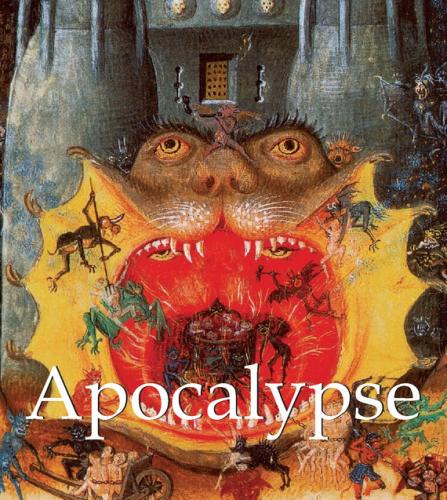Bibliothèque de l’Arsenal, Paris
The existence of a profound and tenacious faith is as old as the centuries, and it is a notable fact that all religions, irrespective of Christian dogma, have opened the same door from this mortal life upon the unknown which lies beyond, it is the door in the Divine Comedy by Dante, although the conceptions of paradise, hell, and purgatory peculiar to the Christian Church, are not universal.
John on Patmos Woken by the Angel
Illustration from “The Douce Apocalypse”, c. 1270
Illumination
University of Oxford, Bodleian Library, Oxford
Zoroaster and the Zend-Avesta taught that the world would perish by fire. The same idea is found in the Epistle of St Peter. It seems that the traditions of Noah and of Deucalion, according to which the first great disaster to humanity came by flood, indicated that the second great disaster would be of an exactly opposite character.
The Angel Proclaims “Who is worthy?” – John Consoled by the Ancient
Illustration from “The Douce Apocalypse”, c. 1270
Illumination
University of Oxford, Bodleian Library, Oxford
Among the Romans, Lucretius, Cicero, Virgil, and Ovid all also announce the future destruction of Earth by fire.
According to Jesus, the generation which he addressed would not die before the previously mentioned disaster occurred.
The Second Seal – The Red Horse
Illustration from “The Douce Apocalypse”, c. 1270
Illumination
University of Oxford, Bodleian Library, Oxford
St Paul, the real founder of Christianity, believed deeply in the resurrection and the coming end of the world, making it a fundamental dogma of the new church. He referenced it eight or nine times in his first epistle to the Corinthians.
Unfortunately for the prophecy, Jesus’ disciples, whom he had assured would not die before his accession, died one after the other under the common law.
The Third Seal – The Black Horse
Illustration from “The Douce Apocalypse”, c. 1270
Illumination
University of Oxford, Bodleian Library, Oxford
St Paul, who did not know Jesus personally, but was a staunch supporter of the fledgling Christian church, was believed to have lived until the Great Commission (Jesus’ appearance to his eleven disciples on Galilee). Naturally, however, they all died, and thus the end of the world, as predicted by the definitive coming of the Messiah, did not happen.
The Third Trumpet – A Burning Star Falls from the Heavens
Illustration from “The Douce Apocalypse”, c. 1270
Illumination
University of Oxford, Bodleian Library, Oxford
Belief in the end of the world did not simply disappear, however. Believers decided to stop taking the prediction literally, seeking instead new interpretations. However, belief in the Gospel suffered as a result. We devoutly buried the dead, laid out in coffins with reverence rather than being burned by fire, and it was written on their tombs that they would rest there until the resurrection.
The Angel of the Sixth Seal and The Four Angels at the Four Corners of the Earth
Cimabue
Fresco
Basilica di San Francesco d’Assisi, Assisi
Jesus would “soon” return to judge “the living and the dead”. The Christian word of recognition was Maran atha, “the Lord will come”.
The apostles Peter and Paul most likely died in the year 64 CE, during the horrible slaughter ordered by Nero after the burning of Rome, set on fire at his command and whose destruction he attributed to the Christians so that he might have a pretext for new persecutions.
The Locusts Riding
Illustration from “The Douce Apocalypse”, c. 1270
Illumination
University of Oxford, Bodleian Library, Oxford
St John wrote his Apocalypse (The Book of Revelation) in the year 69 CE. The reign of Nero was a bloody one, and martyrdom seemed to be the natural consequence of a virtuous life. Prodigies appeared on every hand; there were comets, falling stars, eclipses, showers of blood, monsters, earthquakes, famines, pestilences, and above all, there was the Jewish war and the destruction of Jerusalem.
The War in Heaven
Illustration from “The Douce Apocalypse”, c. 1270
Illumination
University of Oxford, Bodleian Library, Oxford
Never, perhaps, were so many horrors, so much cruelty and madness, so many catastrophes, crowded into so short a period as in the years 64–69 CE. The little church of Christ was apparently dispersed. It was impossible to remain in Jerusalem.
The Dragon Delegates Power to the Beast Who Comes from the Sea
Illustration from “The Douce Apocalypse”, c. 1270
Illumination
University of Oxford, Bodleian Library, Oxford
The horrors of the reign of terror of 1793 and of the Commune of 1871 were nothing in comparison with those of the Jewish civil war. The Jesus’ family was obliged to leave the Holy City and to seek safety in flight. False prophets appeared, thus verifying former prophecies. Vesuvius was preparing the terrible eruption of the year 79 CE, and already, in 63 CE, Pompeii had been destroyed by an earthquake.
The False Prophet Rises from the Earth, Calls Down Fire and Orders the Worship of the Beast
Illustration from “The Douce Apocalypse”, c. 1270
Illumination
University of Oxford, Bodleian Library, Oxford
There was every indication that the end of the world was at hand. Nothing was wanting. The Apocalypse announced that Jesus would descend on a throne of clouds and the martyrs would rise first. The Angel of Mercy would await God’s command.
The Dragon, Who is Satan, Comes Forth Again
Illustration from “The Douce Apocalypse”, c. 1270
Illumination
University
